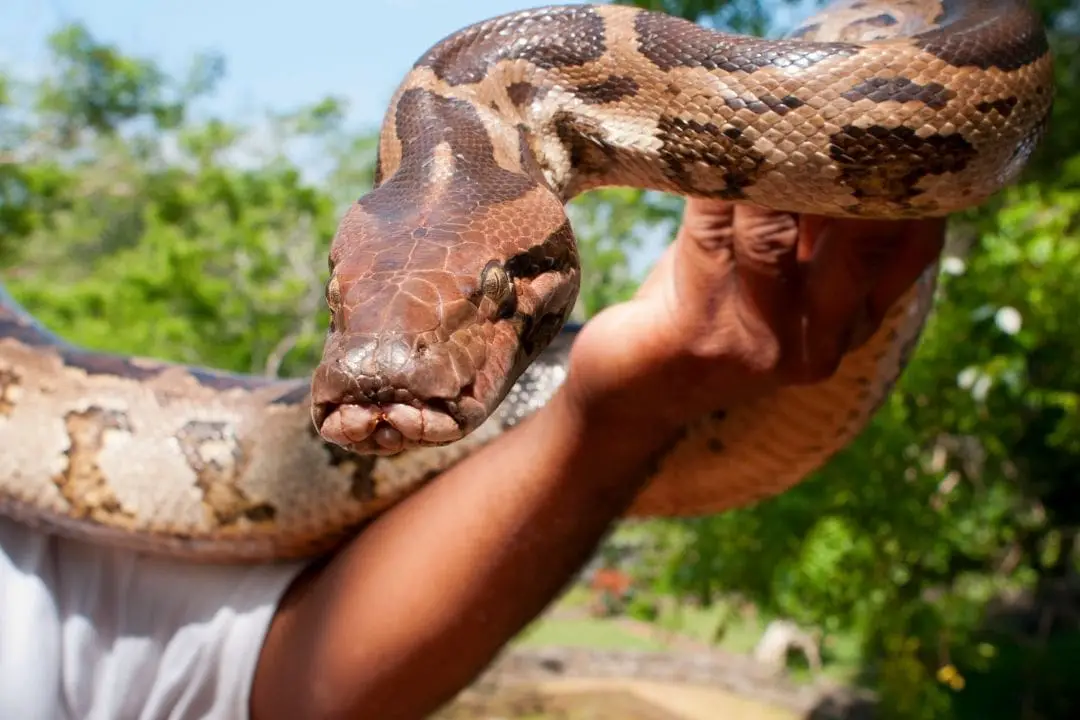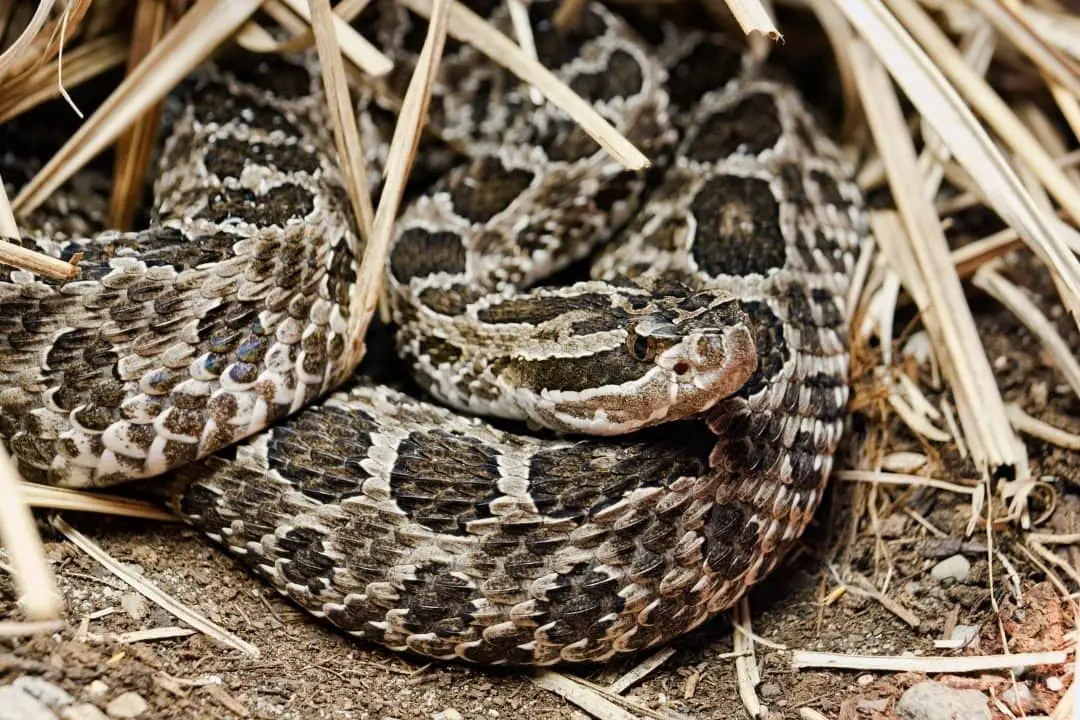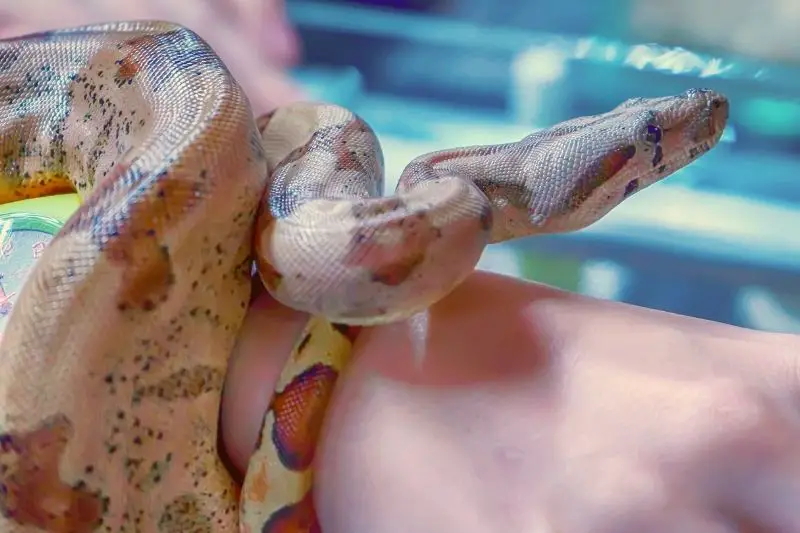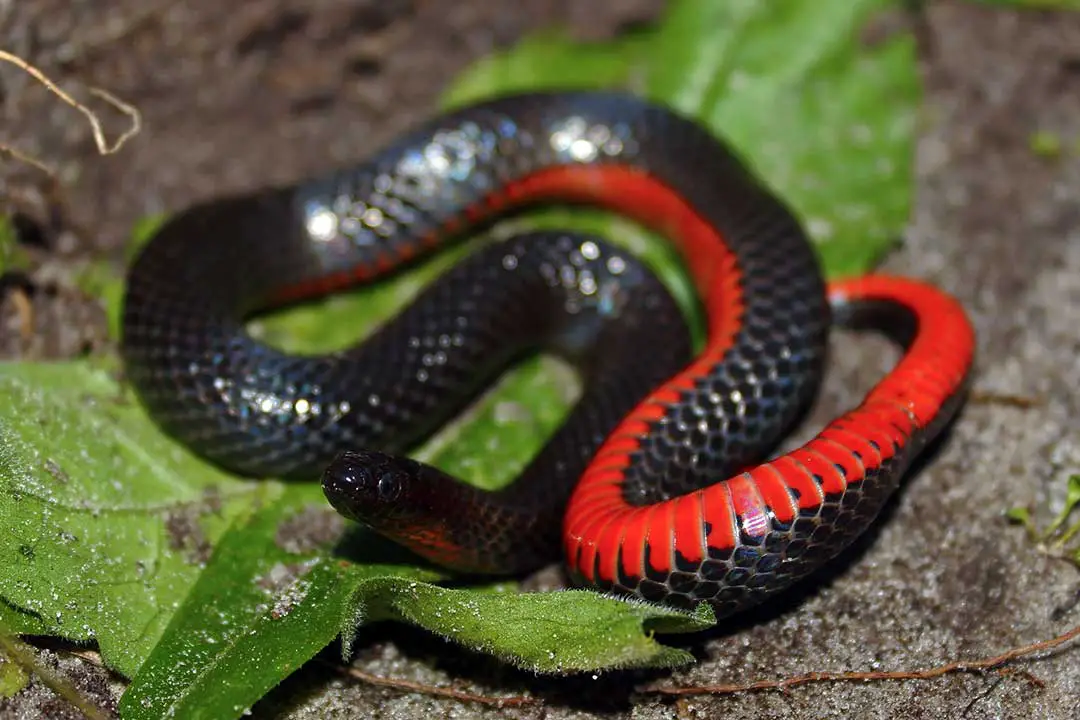Sometimes you just want a large snake. Large snakes are breathtaking animals and many make good pets if you have the space.
Many large snake species can easily be found from captive breeders or available as a rescue.
This article will go over the largest pet snakes, how big each sex gets, and what size of an enclosure you need.
Remember, snakes need to be kept in an enclosure where they can fully stretch out or your snake may experience serious health problems.
The rule of thumb is to get close to the length of the snake on one side of the enclosure.
Climbing species like reticulated pythons need sturdy climbing structures. Water-loving species like Burmese pythons need a large water feature to soak in.
We will note these considerations. Smart snakes like reticulated pythons also need to get plenty of enrichment so they are mentally stimulated.
You will also need an assistant to care for these snakes.
You absolutely must have someone who can help you handle any snake that is over 8 feet long. This is particularly true during feeding and cleaning.
Even sweet snakes can have a bad day and a bite from any snake on this list needs a trip to the doctor for stitches.
Many constricting snakes will also weigh over 100 pounds. You will need help to move the animal to make sure both you and the snake are fine.
1. Reticulated Python
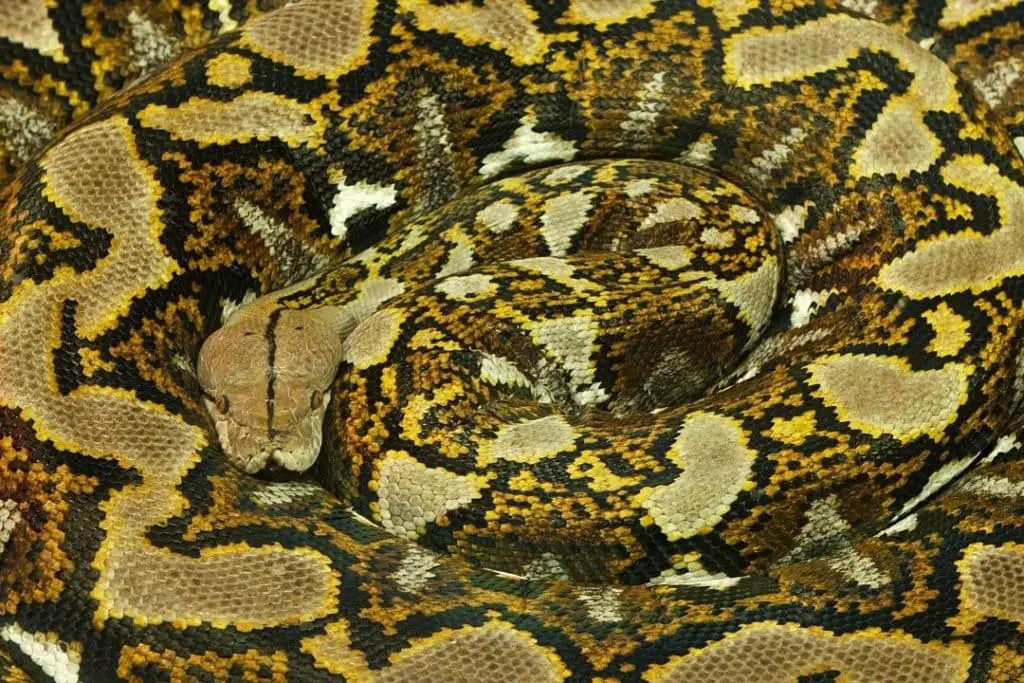
The reticulated python(Python reticulatus) is the longest snake in the world.
These hefty animals reach massive sizes and are some of the smartest nonvenomous snakes in the world.
They are known for being good pets and come in a truly stunning variety of morphs. One important thing to note is that males can get aggressive during their breeding season.
Size: Female reticulated pythons are 16 to 20 feet in captivity and can weigh up to 200 pounds. Males are 10-14 feet long and will weigh around 100 pounds. A dwarf can reach up to 14 feet for females and a super dwarf stays under 10 feet on average.
One important thing to note is that reticulated pythons are very prone to obesity and many breeders recommend power feeding.
While this results in snakes reaching breeding size fast, it seriously shortens the lifespan of the animal and can lead to serious health problems.
They are very prone to obesity and will end up dying young if you are not careful. A healthy snake should be solid but not have any obvious fat deposits.
They should also have a tail that is tapered to the body. If you see a big change between the snake’s pelvis and its tail, it is very obese and needs to be fed less.
Ambush predators like reticulated pythons will take as many meals as they can since they can go months without eating in the wild.
Captive snakes will eat every 4 weeks as adults depending on prey size and the animal’s body condition. Many large snakes can easily fast for three months without being harmed.
Enclosure size: The minimum enclosure size is 10 feet by 6 feet by 6 feet. These snakes are very arboreal if they are not obese. Larger is always better and you should increase the usable space with shelves, ramps, and climbing structures.
A healthy reticulated python is incredibly active for a large snake and climb trees in the wild. They need plenty of space. Ideally, you should offer an enclosure that is as long as the snake.
This means an average female will have a 16-foot long enclosure.
If you cannot manage this, focus on offering more floor space for the snake and maximize your space with climbing structures.
You can also take tame snakes out for exercise around your home or backyard. Just watch the snake, have a helper, and never allow a full-grown snake around other pets.
Offering scent enrichment and changing the enclosure or hiding prey can be great ways to encourage your snake to move and help avoid obesity.
Temperament: Reticulate pythons tend to be fairly calm if you have a snake that is captive-bred and handle it from a young age. Hungry snakes or scared animals can and will bite. Males are also known for becoming aggressive if they can smell another male or a female.
Care should be taken.
Remember, large snakes are only for experienced snake keepers. Reticulated pythons do signal if they are going to bite, but you need to understand snake body language well for this species.
You should also offer this snake a large water feature. They are very strong swimmers and spend a lot of time in or near water in the wild.
You may want to create a water basin that is plumbed in to make filling, draining, and cleaning it easier.
2. Green Anaconda
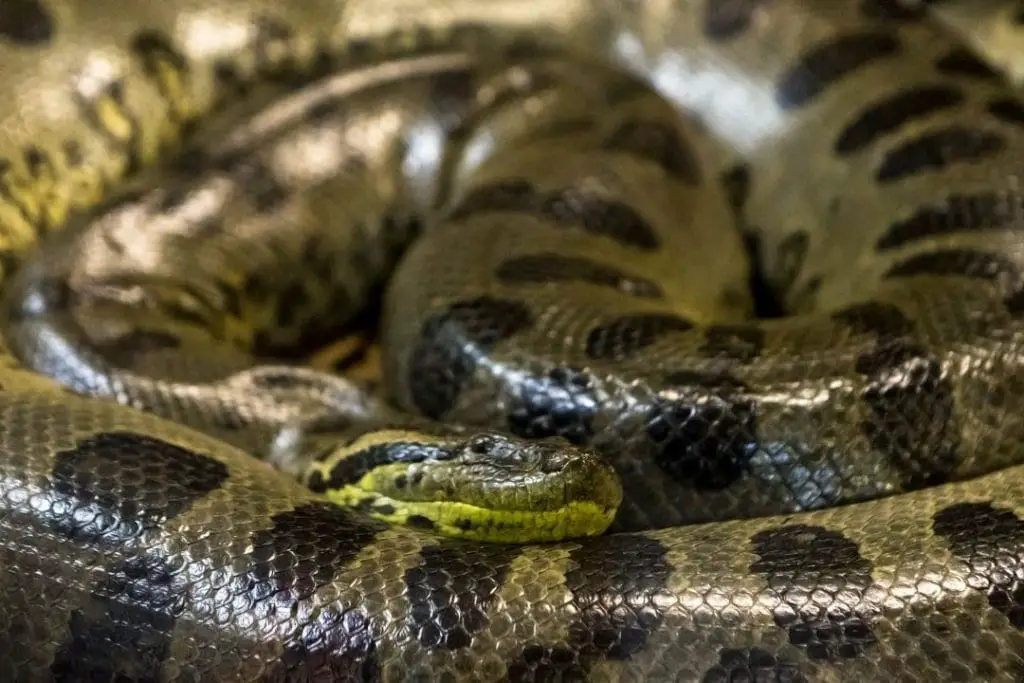
The green anaconda (Eunectes murinus) is the heaviest snake in the world (bigger than the yellow anacondas). While there are reports of the snakes reaching over 30 feet, there has never been a confirmed specimen at this size.
Some wild snakes can reach over 25 feet, but it has been noted that snakes at this size begin having trouble reproducing.
There are several species of anaconda in south america, but the green is the largest and most common. Green anacondas absolutely need a large water feature.
They require very high humidity. If you do not offer a water feature, they are very prone to dehydration.
It is possible but takes serious time and a close eye on the snake and humidity. You also will need to use a substrate that holds humidity. Cypress mulch tends to best.
Size: Males are typically around 10 feet on average, but can reach lengths of 14 feet. Females can be around 15 feet long. They will weigh anywhere from 66 to 154 pounds. They can be much heavier. Captive snakes can be smaller if fed smaller meals.
Please note that the size of the enclosure does not matter to the snake’s maximum size. They will keep growing until they hit their full size.
Enclosure size: If you do not offer a big water feature, you will need to maximize floor space. Green anacondas do not typically climb so you need to offer an enclosure that is at least 8 feet long by 4 feet wide for a small male. A minimum of 10 feet by 5 feet is better for females, but more floor space is always good to keep your snake healthy.
If you intend on offering a water feature, it should cover about one-third of the floor space.
Anacondas normally defecate in the water so you need to either clean the water feature often or install the heavy filters used for fish ponds.
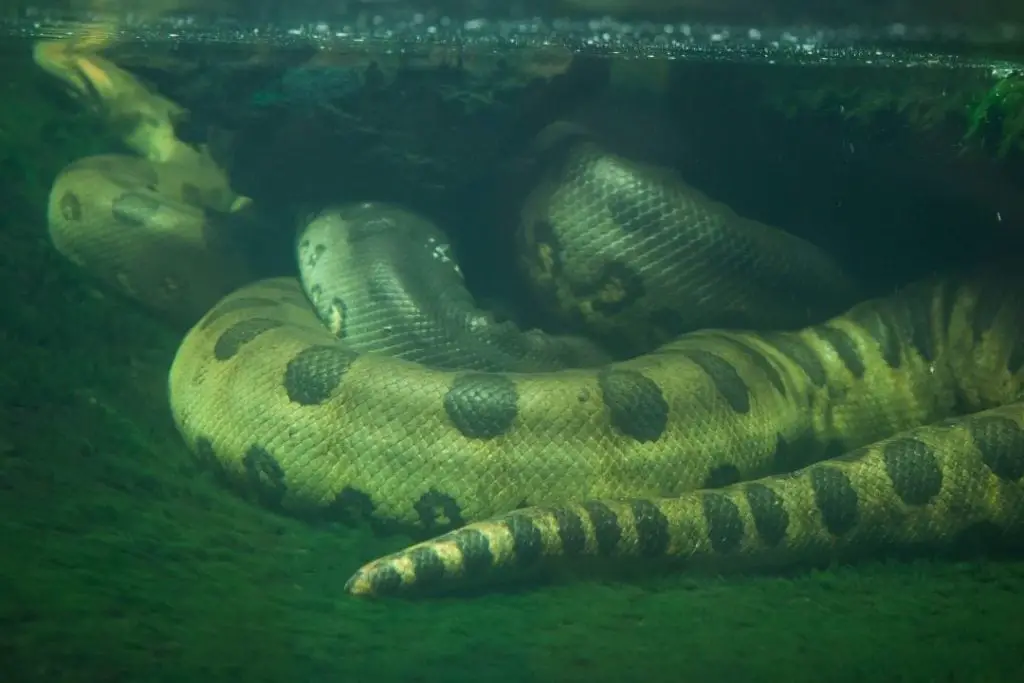
Try to make sure any water feature is at least large enough for the snake to soak its whole body.
Larger is always better for this species, so consider making the enclosure about as long as the snake and half its length in width.
Temperament: Wild-caught green anacondas are very aggressive and tend not to survive long in captivity due to stress and parasites. Captive-bred snakes can be docile if handled from a young age. However, these are very powerful animals and you should aim to have experience with giant snakes before committing to an anaconda.
Green anacondas kill small and medium size animals such as cats and small dogs very easily.
There is also the smaller yellow anaconda, the two species are often mistaken. That is still a pretty large pet snake by most people’s standards.
Burmese pythons make much better pets than green anacondas for someone who has never owned or cared for a giant before.
3. Burmese Python
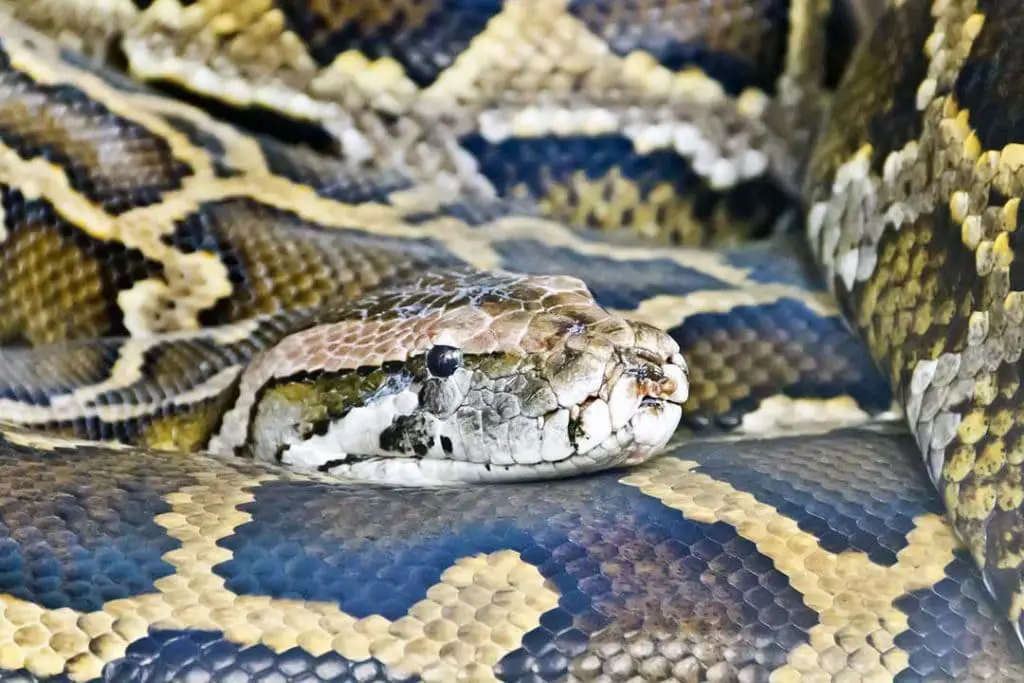
The Burmese python (Python bivittatus) is the best option if you want to find out if a ain’t snake is for you.
If you are a first time ‘giant snake’ owner, the burmese python is my top recommendation.
Captive-bred Burmese pythons are very calm and gentle snakes if handled from a young age.
They are frequently called “puppy-dog” tame by many owners and breeders. They can stay fairly small and light if you are careful not to overfeed them.
This is the best option if you want to try owning one of the true giants. See my complete burmese python enclosure and care guide here, it covers everything you need to know to own one.
They come in a wide range of morphs and you can even find a dwarf population if you want to make sure your snake will stay a bit more manageable.
Size: Burmese pythons tend to stay around 12 feet in captivity. They can reach up to 16 feet, but they weigh less than other large snakes. Females can be 13 to 18 feet and males can be 8 and 14 feet. Females are between 66 and 150 pounds depending on length and males can weigh over 50 feet.
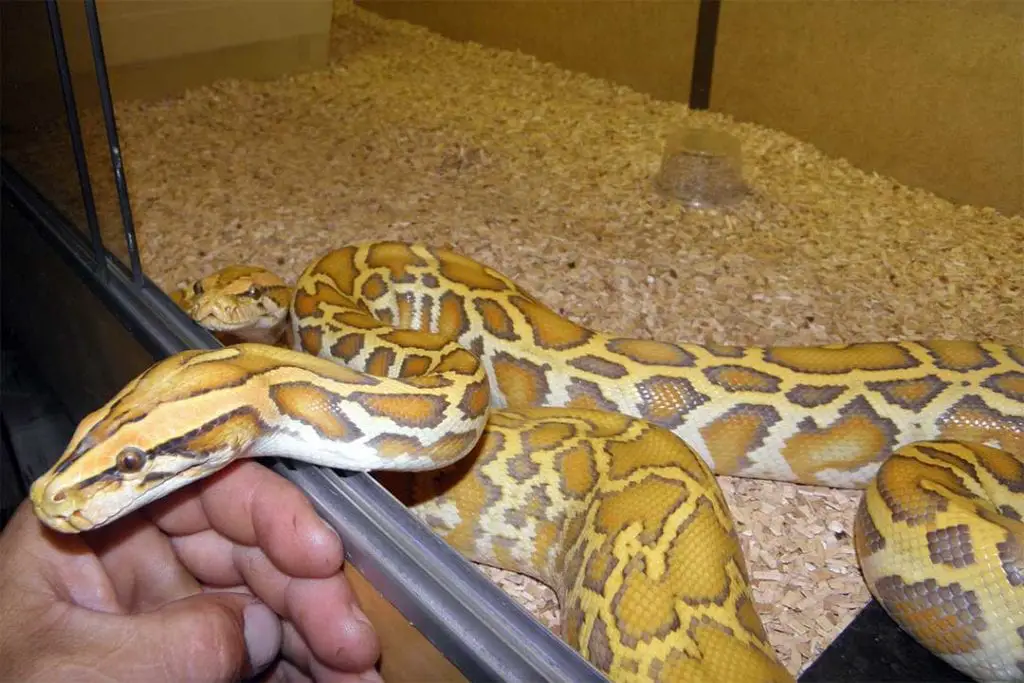
Enclosure Size: 8 feet by 4 feet is the absolute minimum for an adult male. They do like to climb so they need at least 4 feet in height for a male. Females should be kept in 10 feet by 6 feet by 6 feet at a minimum due to their increased girth. You should try to offer at least the snake’s length if possible.
They are very good at climbing so they need very sturdy branches and shelves to climb on. Try to offer plenty of resting options for your snake.
Temperament: Burmese pythons are quite possibly the sweetest of the large snakes. They have a docile personality and take to handling well if you take the time to tame them down as babies. Males can get grumpy during the breeding season but rarely bite or hiss as a reticulated python will.
The main difficulty is their size. They eat small mammals, adults are big and heavy animals even if you are very careful to avoid overfeeding.
If your snake doesn’t want to move, you will not be able to budge it easily.
You need to take the time to learn how to handle large snakes before you buy one.
4. African Rock Python
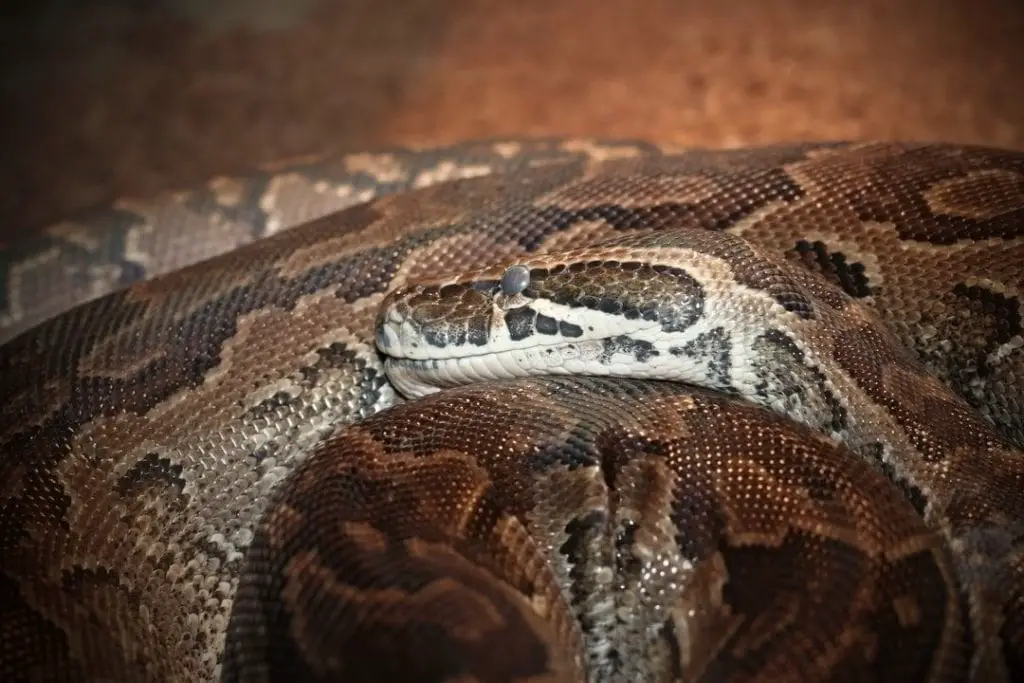
The African rock python (Python sebae) is the largest snake in Africa. These huge snakes have a very foul personality in general. They are snappy and tend to bite.
Most animals available are wild-caught and have all the problems you can expect from a wild snake.
Even captive-bred animals are not at the point where they calm down yet.
This may be a feature of the average member of the species. Only the most advanced keepers should own african rock pythons!
They can sometimes be mistaken for ball python when young, but this is a very different beast.
Size: Males are on average smaller and lighter than females. The average length of these large constrictors is about 11 feet, but 15-foot females are not uncommon. They can reach nearly 20 feet long, but this is incredibly rare and has never been seen in a captive animal. Most animals will not weigh over 70 pounds, but they can reach 200 pounds for very large animals.
African rock pythons from the northern portions of its range are much longer than southern snakes. The southern population is considered a separate species, but most places selling them still call these the same species.
Enclosure size: 10 feet by 6 feet is the minimum for the species. They are not huge on climbing but they do like structures similar to the rocks they live on and under in their native habitat. Offering larger is always better and can make cleaning the enclosure safer if your snake doesn’t like you coming in to clean.
Temperament: Some captive-bred animals will tame down, but they can be very mean. Thanks to their sheer size this makes them a dangerous animal to own if you do not have experience in large snakes.
Only get one if you can handle a snake that tries to take a bite out of you daily.
5. Coastal Carpet Python
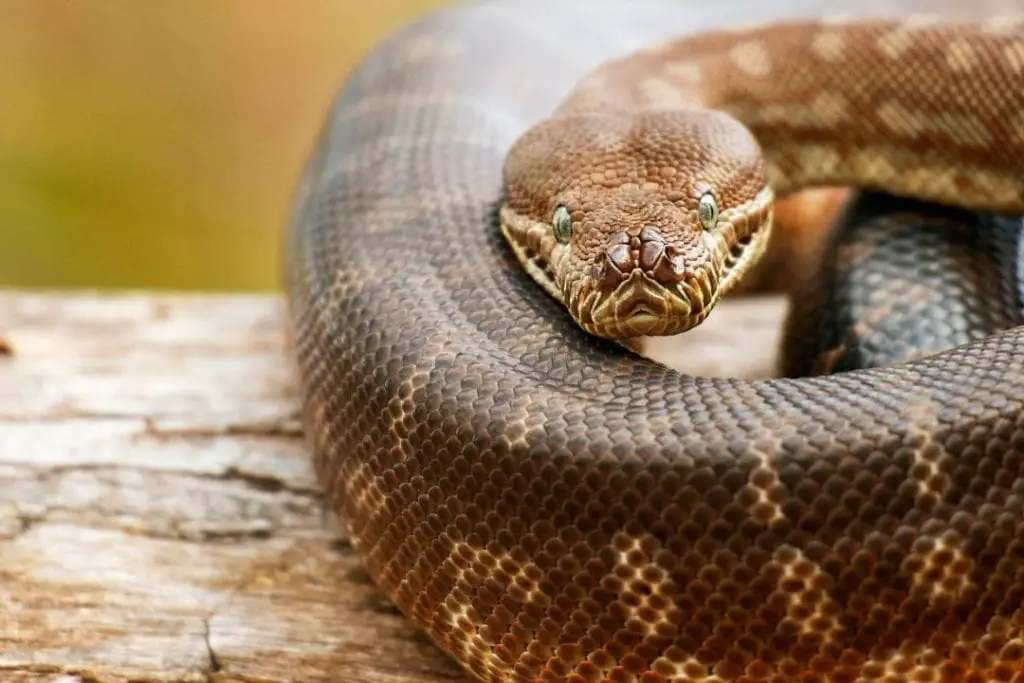
The coastal carpet python (Morelia spilota mcdowelli) is the largest subspecies of the carpet python. Other subspecies can get large but never beat the coastal subspecies.
They are much more common in their native Australia and it can be a struggle to find some subspecies and morphs outside of the country.
Size: Males and females will regularly reach over 8 feet long with females typically reaching 9 feet and more. They can grow to be over 12 feet long. They can weigh over 30 pounds.
Enclosure size: For a coastal carpet python, at least 8 feet by 4 feet is ideal with a similar height. Large females may need a 10 foot by 6-foot enclosure. Carpet pythons are very active. Aim to offer multiple branches for climbing and ledges to encourage exercise. You will also need a large hide for these snakes.
Temperament: Coastal carpet pythons are known for being more defensive than other carpet pythons. This does depend on the animal.
They are easier to handle than many other large snakes due to their lighter weights as adults. Most carpet pythons are very docile if they are captive-bred and handled from a young age.
Just note that all snakes are individuals and may be more or less tolerant to handling than other snakes.
6. Boa Constrictor
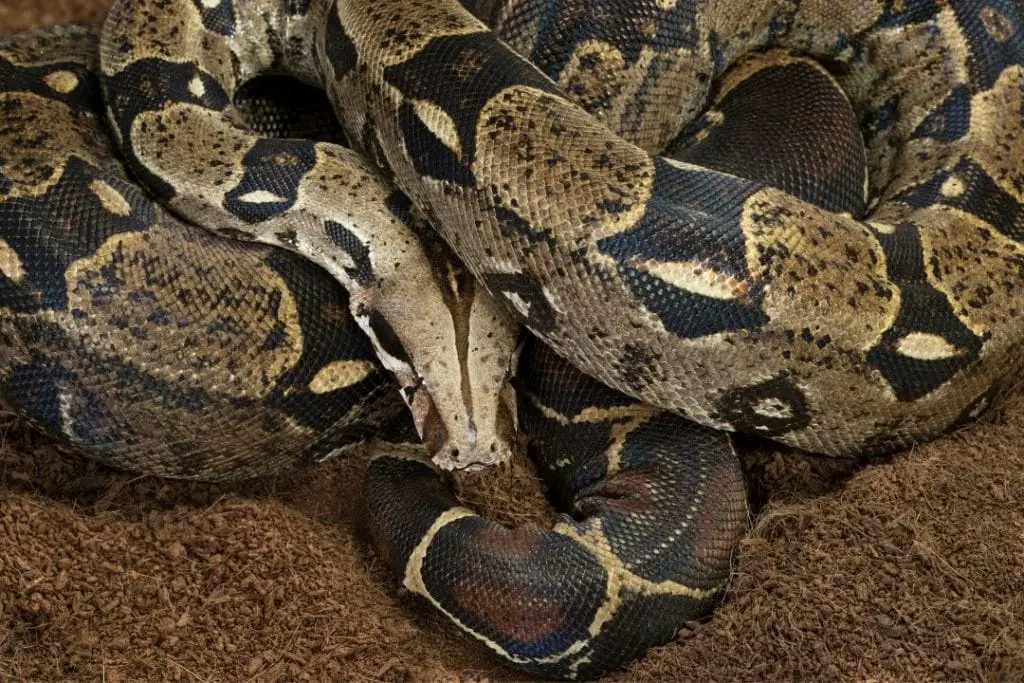
The boa constrictor (Boa constrictor) is a very common pet snake: I published a complete care guide for boa constrictors here, that covers enclosure setup, feeding and daily care.
They can get large depending on the species and population.
Many animals sold as boa constrictors are actually Boa imperator since they entered the pet trade before it was known that these snakes were a separate species rather than a subspecies in the snake world.
Check what animal you are getting and ask the breeder about the size of the parents.
This can give you a good idea of what size the full-grown adult will be. Boa constrictors are one of the best pet snakes due to their docile personality and a high tolerance for handling in most snakes.
They can get large, so be sure you are prepared. They are definitely the largest of the common snakes in the pet trade.
Size: Females can be between 7 and 10 feet, but animals up to 13 feet can be found in some areas and in captivity. Males are smaller and thinner on average and will stay around 6-8 feet on average. Females can weigh between 22 and 33 pounds, but very large snakes can be heavier. Males are lighter on average.
Enclosure Size: A small male can be fine in a 6 foot by 3 foot, but 8 feet by 4 feet by 4 feet is the standard for the species. Larger females will need more space. They do enjoy climbing, so offer plenty of options to encourage exercise.
They will get very fat if you are not careful with your snake. Offer ledges, climbing spaces, and plenty of hiding options to encourage your snake to move.
Temperament: Boa constrictors are very docile animals and are frequently used for educational programs since they are the largest snake that is safe to allow around older children. The giants should never be near children.
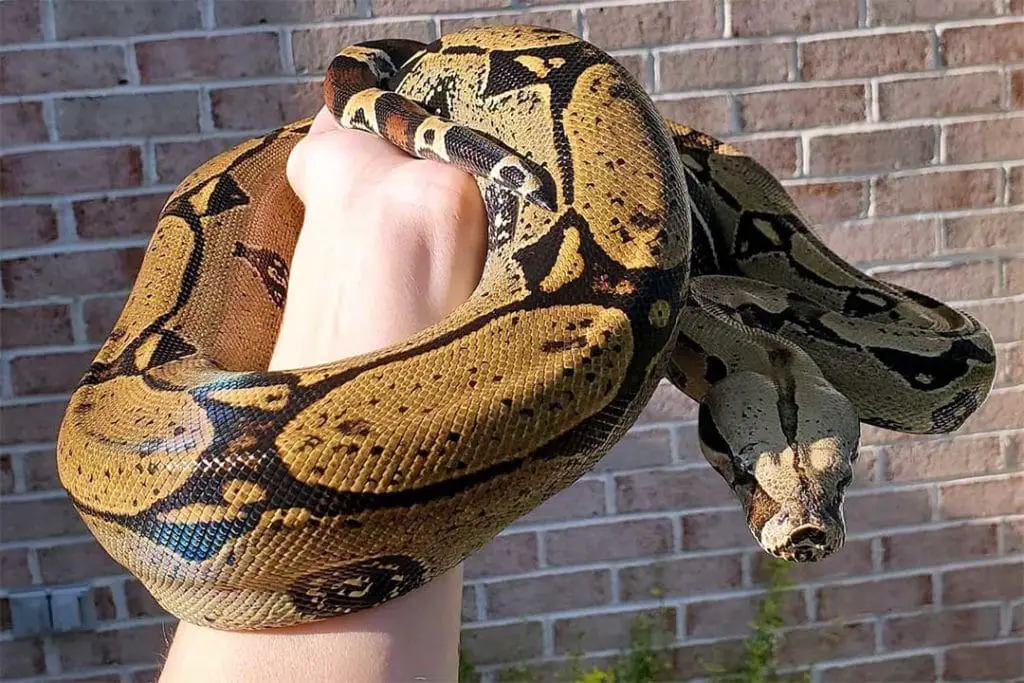
This does not mean they are a good pet for a child since they can easily get to a size that only an adult can safely handle.
They are very strong but rarely bite if treated well and taught that humans are safe from a young age. They are common pets so you can easily find amazing morphs.
Be sure you only buy captive-bred since wild-caught snakes are very defensive and will not be shy about biting you.
Conclusion
We hope this has taught you a bit about the largest snakes. Large snakes are dangerous due to their size and strength.
Never allow anyone under 18 to handle a giant and never handle them without someone nearby. A bite or squeeze from these snakes can cause serious damage if you are alone.
Make sure your helper knows that hand sanitizer, a drop of rubbing alcohol, or an ice cube on the snout are the fastest and safest ways to get a snake to release you.
If you have any comments or questions, please leave them below.
